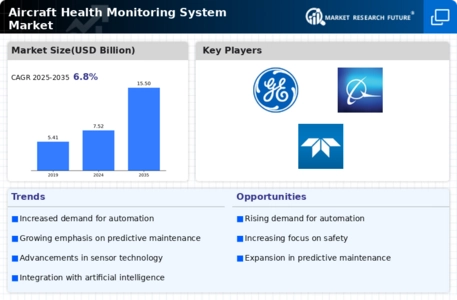Emergence of Smart Aircraft Technologies
The emergence of smart aircraft technologies is reshaping the Aircraft Health Monitoring System Market. Innovations such as the Internet of Things (IoT) and connected aircraft systems are enabling real-time data transmission and analysis, which enhances the monitoring of aircraft health. These technologies facilitate proactive maintenance strategies, allowing operators to address issues before they impact flight operations. The market for smart aircraft technologies is anticipated to grow significantly, with projections indicating a substantial increase in the adoption of IoT-enabled systems. As these technologies become more prevalent, they are expected to drive the demand for health monitoring systems, thereby influencing the Aircraft Health Monitoring System Market positively.
Growing Demand for Operational Efficiency
The Aircraft Health Monitoring System Market is experiencing a surge in demand for operational efficiency among airlines and aircraft operators. This demand is driven by the need to reduce operational costs while maximizing aircraft availability. By implementing health monitoring systems, operators can identify potential issues before they escalate, thereby minimizing downtime and maintenance costs. According to industry estimates, the adoption of these systems can lead to a reduction in maintenance costs by up to 30%. As airlines strive to enhance their operational capabilities, the integration of health monitoring systems becomes increasingly vital, suggesting a robust growth trajectory for the Aircraft Health Monitoring System Market.
Increasing Focus on Safety and Compliance
The Aircraft Health Monitoring System Market is significantly influenced by the increasing focus on safety and regulatory compliance. Aviation authorities worldwide are implementing stringent safety regulations that necessitate the adoption of advanced monitoring systems. These systems not only ensure compliance with safety standards but also enhance the overall safety of flight operations. The market is expected to witness a steady growth rate as airlines prioritize safety measures to avoid penalties and enhance their reputation. Furthermore, the integration of health monitoring systems is likely to become a standard practice, reinforcing the importance of safety in the Aircraft Health Monitoring System Market.
Rising Investment in Aviation Infrastructure
Rising investment in aviation infrastructure is a key driver for the Aircraft Health Monitoring System Market. Governments and private entities are increasingly investing in modernizing airports and upgrading aircraft fleets, which includes the implementation of advanced health monitoring systems. This trend is particularly evident in emerging markets, where the expansion of air travel is prompting the need for enhanced operational capabilities. The global investment in aviation infrastructure is projected to reach trillions of dollars over the next decade, creating a favorable environment for the growth of health monitoring systems. As infrastructure improves, the demand for sophisticated monitoring solutions is likely to escalate, further propelling the Aircraft Health Monitoring System Market.
Technological Advancements in Data Analytics
Technological advancements in data analytics are significantly influencing the Aircraft Health Monitoring System Market. The integration of big data analytics and machine learning algorithms allows for real-time monitoring and predictive analysis of aircraft health. This capability enables operators to make informed decisions based on comprehensive data insights, potentially reducing maintenance-related delays. The market for data analytics in aviation is projected to grow substantially, with estimates indicating a compound annual growth rate of over 15% in the coming years. As these technologies evolve, they are likely to enhance the effectiveness of health monitoring systems, thereby driving the Aircraft Health Monitoring System Market forward.


















Leave a Comment